Then there’s this modification we want to make. Consider instead a circle having as diameter the line segment connecting the orthocenter with the circumcenter (the Euler line). This circle passes through vertex ![]() of a parent triangle
of a parent triangle ![]() if, and only if, the side-lengths
if, and only if, the side-lengths ![]() satisfy
satisfy
(1) ![]()
The reflection of the circumcenter over side ![]() also passes through this circle, under the above equivalence.
also passes through this circle, under the above equivalence.
Let ![]() be the circumradius of the circle. In the diagram below
be the circumradius of the circle. In the diagram below
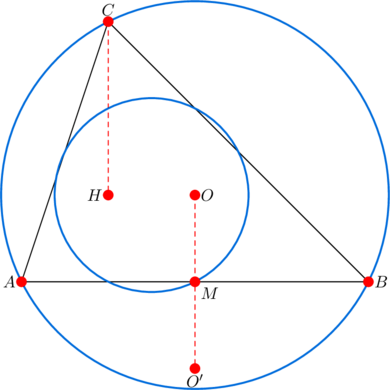
![]() is the midpoint of
is the midpoint of ![]() and
and ![]() is the reflection of
is the reflection of ![]() over
over ![]() , and so
, and so ![]() . Since
. Since ![]() and
and ![]() , we have:
, we have:
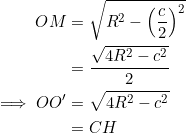
In the diagram below, ![]() is the midpoint of
is the midpoint of ![]() , and so
, and so ![]() is a median in triangle
is a median in triangle ![]() .
.
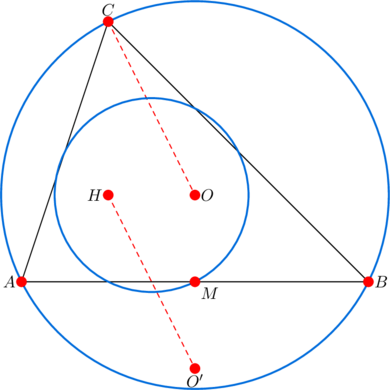
So:
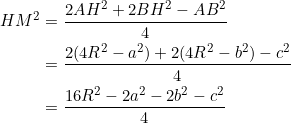
Similarly, ![]() is the midpoint of
is the midpoint of ![]() , and again
, and again ![]() is a median in triangle
is a median in triangle ![]() :
:

This follows from the two preceding examples, since we now have ![]() and
and ![]() .
.
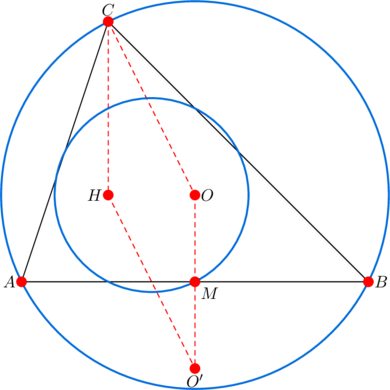
(Main goal)
If equation (1) is satisfied, then from one of the equivalent statements here, the segment ![]() is perpendicuclar to the radius
is perpendicuclar to the radius ![]() .
.
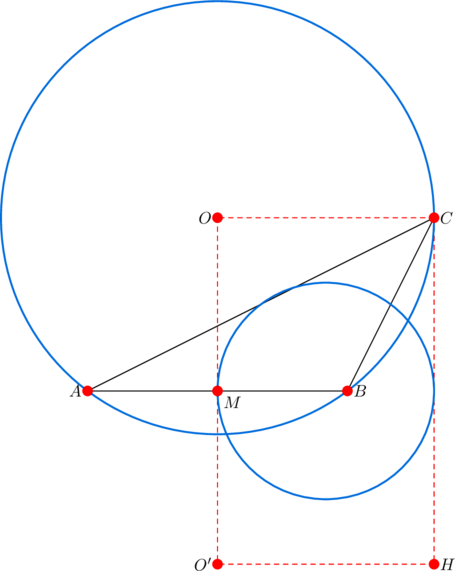
Since the quadrilateral ![]() is a parallelogram, it follows that it is a rectangle. Consequently, the points
is a parallelogram, it follows that it is a rectangle. Consequently, the points ![]() are concyclic. And the circle through these four points shares the same center with the nine-point center of the parent triangle.
are concyclic. And the circle through these four points shares the same center with the nine-point center of the parent triangle.
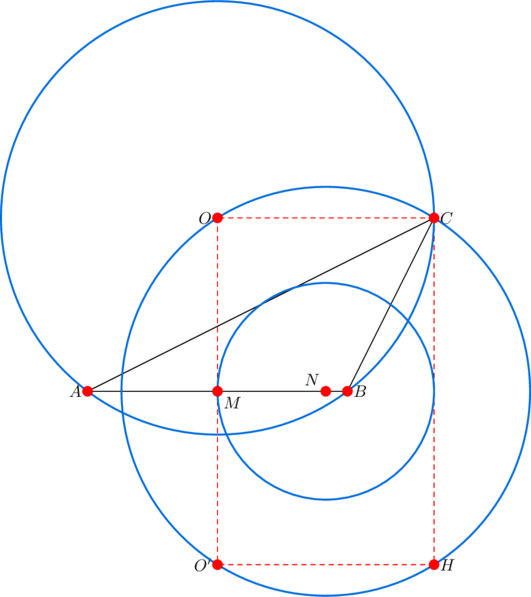
Since ![]() is a diameter, the triangle
is a diameter, the triangle ![]() is right-angled at
is right-angled at ![]() . By one of the equivalent statements here, we conclude that equation (1) holds.
. By one of the equivalent statements here, we conclude that equation (1) holds.
Takeaway
In a non-right ![]() , let
, let ![]() be the side-lengths,
be the side-lengths, ![]() the orthocenter,
the orthocenter, ![]() the circumcenter, and
the circumcenter, and ![]() the reflection of the circumcenter over side
the reflection of the circumcenter over side ![]() . Then the following statements are equivalent:
. Then the following statements are equivalent:

 is right-angled at
is right-angled at 
 is right-angled at
is right-angled at 
- quadrilateral
 is a rectangle
is a rectangle - points
 are concyclic with
are concyclic with  as diameter.
as diameter.
Task
- (Half century) In a non-right triangle
 , let
, let  be the side-lengths,
be the side-lengths,  the altitudes,
the altitudes,  the feet of the altitudes from the respective vertices,
the feet of the altitudes from the respective vertices,  the circumradius,
the circumradius,  the circumcenter,
the circumcenter,  the nine-point center,
the nine-point center,  the orthocenter,
the orthocenter,  the midpoint of side
the midpoint of side  , and
, and  the reflection of
the reflection of  over side
over side  . PROVE that the following fifty statements are equivalent:
. PROVE that the following fifty statements are equivalent:




























 is congruent to
is congruent to 
 is isosceles with
is isosceles with 
 is isosceles with
is isosceles with 
 is right angled at
is right angled at 
 is the circumcenter of
is the circumcenter of 
 is right-angled at
is right-angled at 
 is right-angled at
is right-angled at 
- quadrilateral
 is a rectangle
is a rectangle - the points
 are concyclic with
are concyclic with  as diameter
as diameter - radius
 is parallel to side
is parallel to side 
 is the reflection of
is the reflection of  over side
over side 
- the nine-point center lies on

- the orthic triangle is isosceles with

- the geometric mean theorem holds
- the bisector of
 has length
has length  , where
, where 
- the orthocenter is a reflection of vertex
 over side
over side 
- segment
 is tangent to the circumcircle at point
is tangent to the circumcircle at point 
- median
 has the same length as the segment
has the same length as the segment 
- the bisector
 of
of  is tangent to the nine-point circle at
is tangent to the nine-point circle at 
 is a convex kite with diagonals
is a convex kite with diagonals  and
and 
- altitude
 is tangent to the nine-point circle at
is tangent to the nine-point circle at 
- segment
 is tangent to the nine-point circle at
is tangent to the nine-point circle at  .
.
(Quite plenty, but can we reach ?)
?)
- (Extra feature) If
 satisfies equation (??), PROVE that its nine-point center
satisfies equation (??), PROVE that its nine-point center  divides
divides  in the ratio
in the ratio  .
.